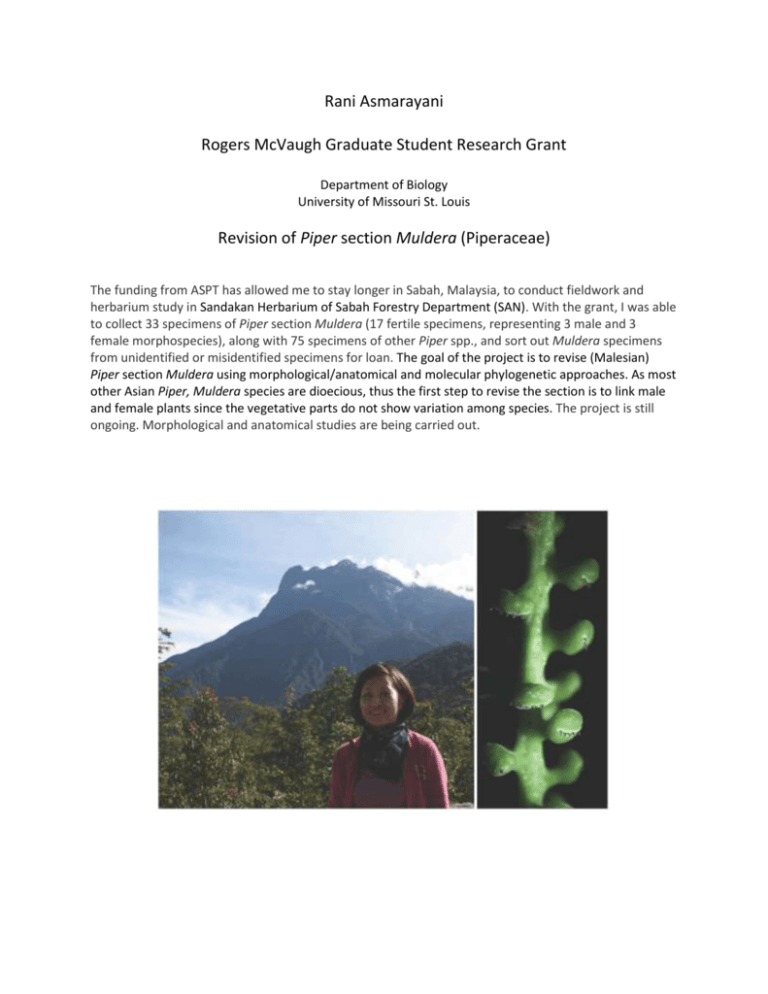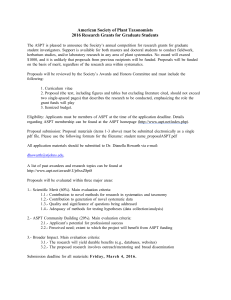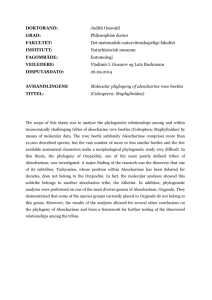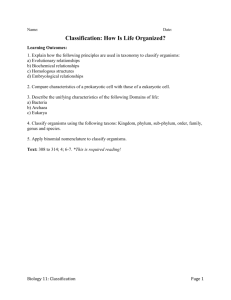Piper - American Society of Plant Taxonomists
advertisement

Rani Asmarayani Rogers McVaugh Graduate Student Research Grant Department of Biology University of Missouri St. Louis Revision of Piper section Muldera (Piperaceae) The funding from ASPT has allowed me to stay longer in Sabah, Malaysia, to conduct fieldwork and herbarium study in Sandakan Herbarium of Sabah Forestry Department (SAN). With the grant, I was able to collect 33 specimens of Piper section Muldera (17 fertile specimens, representing 3 male and 3 female morphospecies), along with 75 specimens of other Piper spp., and sort out Muldera specimens from unidentified or misidentified specimens for loan. The goal of the project is to revise (Malesian) Piper section Muldera using morphological/anatomical and molecular phylogenetic approaches. As most other Asian Piper, Muldera species are dioecious, thus the first step to revise the section is to link male and female plants since the vegetative parts do not show variation among species. The project is still ongoing. Morphological and anatomical studies are being carried out. Guillaume Chomicki Department of Biology University of Munich, Munich Testing the extent of coevolution between the Hydnophytinae (Rubiaceae, Pyschotriae) and Philidris ants (Dolichoderinae) Funds from the ASPT Graduate Student Research Grant participated to fund my fieldwork in Fiji. In Fiji, I studied a small genus (Squamellaria) of Rubiaceae that live in symbiosis with the ant Philidris nagasau. During this fieldtrip, I discovered three new species, and documented a uniquely specialized ant/plant symbiosis. I also conducted several experiments involving 15N labeling, to test the extent of nutritional specialization in Squamellaria and its closest relatives forming facultative symbioses. A manuscript with new species descriptions is in review and other manuscripts resulting from this fieldwork are underway. I am very grateful to the ASPT for providing funding for my research. Laura Clavijo Department of Biological Sciences University of Alabama, Tuscaloosa Systematics of the Neotropical genus Drymonia (Gesneriaceae) The funds I received from the ASPT were used to complete the data generation for my dissertation titled “Systematics of the Neotropical genus Drymonia (Gesneriaceae)”. The funds allowed me to complete the molecular dataset for 197 taxa of the subtribe Columneinae, with emphasis on the genus Drymonia (90 out of 102 species). With this dataset, I was able to generate a phylogenetic hypothesis that supports the monphyly of the genus, and its close relationship with highly diverse, Andes-centered genera (i.e., Columnea, Glossoloma, Alloplectus and Neomortonia). We found six strongly supported clades within Drymonia, each of them showing great morphological diversity, which supports the hypothesis that convergence in floral traits is pervasive across all Neotropical Gesneriaceae. However, the relationships among these clades are not resolved. Thanks to the support of the ASPT, I am currently in the final steps of writing my dissertation and complete my doctoral studies. Gabriel Damasco Department of Integrative Biology University of California, Berkeley Shedding light on the adaptive evolution of a dominant and widespread plant lineage in the Neotropics The ASPT award covered my fieldwork expenses in Brazil during the summer of 2014. I was able to finish the specimen collecting activity and to increase the sampling effort of my dissertation project. Currently, I am performing the lab work for population genetics analysis and the samples will be sent to sequencing facility in the beginning of 2016. Preliminary phylogenetic analysis based on multiple nuclear genes showed that P. heptaphyllum populations are polyphyletic and this taxon should not be classified as a single hyperdominant species. According to the phylogenetic species concept, this clade could be divided into five different diverged plant lineages. Although we have not yet achieved a desired phylogenetic resolution, our results suggest that conclusions made upon the hyperdominance phenomenon in the Amazon should be more cautious and conservative, because there is a great chance of hyperdominant species representing multiple incipient diverged lineages. Amanda Everett Department of Biology University of San Diego, San Diego Revisiting the Phylogenetic Systematics of Pogogyne using low-copy nuclear markers and NGS genome skimming data Currently I am in my second to last semester of my graduate program in evolutionary biology at SDSU, and I am in the first stages of the final series of analyses for my thesis. The funds that were contributed by the ASPT were used to directly cover the cost of fuel during one of my two collecting trips. During this trip I was able to acquire samples of a putatively novel taxon, in addition to taxa from populations of the same species having variable phenotypes. These samples are critical to the significance of my research, as they will inform questions about speciation within the vernal pool habitat. Without these funds, my sampling would have been reduced by roughly one-third, which is very significant for this analysis in light of the size of this genus (8 extant species). Karolina Heyduk Department of Plant Biology University of Georgia, Athens The funds provided by ASPT have allowed me to sample C3-CAM Yucca hybrids to assess how photosynthesis varies in these hybrid populations. With the help of Wendy Hodgson at the Desert Botanical Garden, we’ve sampled a number of individuals and their C3 and CAM parental species and are currently analyzing the data. In addition, we’re working to generate sequence capture data on the same individuals to link genotypic variation to photosynthetic variation. Together, photosynthetic pathway information and genetic diversity of hybrid Yucca populations will provide novel data on photosynthetic pathway evolution in hybridizing species. We’re excited to continue to make progress with the help of funding from ASPT! Melissa Johnson Department of Botany Claremont Graduate School, Claremont Testing the non-adaptive speciation hypothesis on islands: Pacific Cyrtandra (Gesneriaceae) as a model of species radiation decoupled from ecological diversification Funding from ASPT permitted me to conduct fieldwork in the islands of Fiji from June-August 2014. On this expedition I was able to visit 10 sites across the islands of Viti Levu, Vanua Levu, and Taveuni. In total, I collected 75 specimens representing 25 species, five of which are new to science. These specimens, in combination with DNA sequences acquired from silica-dried leaf material, will be used to produce a new phylogenetically informed taxonomic treatment of the Fijian species of Cyrtandra. In addition, functional trait data was collected to aid in understanding the ecological requirements of coexisting species. Seeds were also collected from a subset of species and are currently being grown in a controlled setting to provide baseline information on germination and growth requirements. Lastly, digital photographs were taken of vegetative and reproductive material, and pickled samples of flowers and fruits were collected to aid in taxonomic revisions of species. I am currently analyzing data, and plan to have the results published by early 2017. Jacob Landis W. Hardy Eshbaugh Graduate Student Research Grant Department of Biology University of Florida, Gainesville Evolution of Flower Color and its Significance in Polemoniaceae: Phylogeny Reconstruction and Character Mapping in Leptosiphon and Linanthus The funds I received were pooled with a few other smaller grants to pay for the cost of a NextSeq Highthroughput run to sequence 168 samples from a targeted gene capture protocol. All the data has been collected and analyses are underway with a pipeline that has been established to generate reliable results. One of the undergrads in our lab that was helping on the project presented some of the initial findings at the 2015 Botany meeting in Edmonton. Shi-Hui Liu Department of Biology Saint Louis University, St. Louis Phylogeny of Ludwigia and polyploid evolution in section Macrocarpon (Onagraceae) Polyploidization has been considered as one of the main forces in angiosperm evolution. With support from the American Society of Plant Taxonomists 2014 Research Grant and other funds, I had obtained necessary molecular data to reconstruct a comprehensive phylogeny of the polyploid extensive genus Ludwigia and had generated huge data by using Next Generation sequencing (NGS) for understanding the polyploid evolution of section Macrocarpon, which has distinct geographical distribution and polyploid patterns. In genus-wide phylogeny, two nuclear markers and five chloroplast markers were applied. Six outgroups from other genus and 85% of species in Ludwigia representing 95% of sections were analyzed. For the sect. Macrocarpon, ten individuals representing all species in the section and two outgroups from other sections were sampled. Approximately 1.2 million paired end reads were generated per sample. The manuscript according to my genus-wide phylogeny is being prepared and the NGS data of sect. Macrocarpon are currently being analyzed. The ASPT Research Grant was used for parts of NGS costs. It helped me a lot to explore NGS technique and obtain NGS data essential to my dissertation. I am very honored to be awarded and deeply appreciate the support from the ASPT. Makenzie Mabry Department of Biology San Diego State University, San Diego Evaluating the Monophyly and Biogeography of the Genus Cryptantha (Boraginaceae) With assistance from ASPT, I successfully completed my master’s research project. I sequenced 81 taxa using genome skimming methods to capture a majority of the chloroplast genome, the complete ribosomal cistron, and 23 mitochondrial genes. Phylogenetic analyses resulted in three major clades of Cryptantha taxa, each composed of taxa from both North and South America. Character state reconstruction recovered a single evolution event of cleistogamy, a self-pollination method, with one possible reversal. Using biogeographic and divergence dating methods, four unidirectional dispersals from North to South America were recovered. Divergence of these South America clades roughly corresponds with major geological changes of the South America terrain, such as the rise of the Andes. Currently, the best working hypothesis of how these plant propagules are dispersing is that of migratory birds. Long distance migratory birds can travel thousands of miles in a single flight. Since there are no known fossils of Cryptantha plant, nutlets, or pollen in the tropics, at this point it is reasonable to assume that these species never occurred there, supporting the hypothesis that this distribution is in fact caused by dispersal events, not a widespread population with subsequent extinction in the tropics. Rob Massatti William R. Anderson Graduate Research Award Department of Ecology and Evolutionary Biology University of Michigan, Ann Arbor Testing the Bering Land Bridge’s influence on the diversification of the montane flora I used funding from ASPT to generate next-generation sequencing data for a library that included over 70 species from Carex section Racemosae (Cyperaceae) and closely related sections. I used this data to construct a highly resolved phylogeny by both concatenating SNPs and treating them as independent loci; the best-supported phylogeny was robust to different inference methods. The phylogeny allowed me to conduct an ancestral range reconstruction to determine if ancestors were either restricted to North America or Asia, or were widespread at northern latitudes. Distributional patterns within the phylogeny suggest that, while species adapted to habitat at northern latitudes freely dispersed between continents during the Pleistocene, species adapted to montane regions were largely regionally restricted. Considering the shared similarity of evolutionary lineages between mountain ranges in Asia and North America at more southern latitudes, these data suggest that the dispersal of high latitude species into mountain ranges at southern latitudes, and their subsequent isolation and diversification, may be responsible for observed floristic patterns. My research is complete, but the mechanism generating shared diversity suggested by my work requires further testing. Wyatt Sharber Department of Biology University of Miami, Coral Gables The role of the West Indies in the evolution and biogeography of Ayenia L. (Malvaceae; Byttnerioideae) My funding from the ASPT has allowed me to continue my research on the evolution and biogeography of the diverse, New World genus, Ayenia. My work focuses on Caribbean taxa: their origins, diversification, and migration patterns. With ASPT funding, I have been able to sequence multiple DNA markers and expand my sampling to 55 of the ca. 80 species of Ayenia, including several taxa from Cuba and Haiti. Data collection is ongoing, yet initial phylogenetic analyses resolve the major clades of Ayenia, support a tropical South American origin of the genus, and recover multiple origins of Caribbean taxa. Rebecca Stubbs Department of Biology University of Florida, Gainesville Micranthes (Saxifragaceae) as a model for large-scale biogeographic inference Funds from ASPT were used to collect Micranthes (Saxifragaceae) from eight states in North America during my first field season for my Ph.D. research at University of Florida. This field season, spanning the Appalachians, Rockies, Sierra Nevada, Cascades, and Coast Ranges – resulted in the collection of 62 specimens. These specimens were used for 1) creating voucher specimens that were deposited at multiple U.S. herbaria, 2) collecting leaf tissue to dry in silica for DNA extraction and use in molecular phylogenetic analysis, and 3) for growing a living collecting which is being used for chromosome counts from root tip squashes. I also documented my adventures as a botanist through a website dedicated to my research (www.RebeccaLStubbs.com), which includes an online journal, photos, and videos. My first field season would not have been as successful without the support from ASPT, and the specimens resulting from these funds are included in my preliminary analyses. Lindsey Worchester Department of Botany Oklahoma State University, Stillwater Phylogeny and Biogeography of the Podostemam Clade, Asclepias L. (Apocynaceae) The ASPT Graduate Student Research Grant was used to cover sequencing costs, buy two PCR, and purchase ethyl alcohol to keep a sterile environment for doing lab work. My project is mostly completed. I am in the process of reanalyzing data and writing up my thesis for publication. I was able to sequence 5.5 plates of clones, complete sampling of all species in my group by adding sequences from four species, and add in nine individuals to sample the genetic variation across the range of each species. I was also able to amplify DNA from old herbarium specimens to help supplement sampling for two species I was unable to collect in the field, and to help cover gaps in sampling across the ranges of species.









